Sourdough Rye Bread
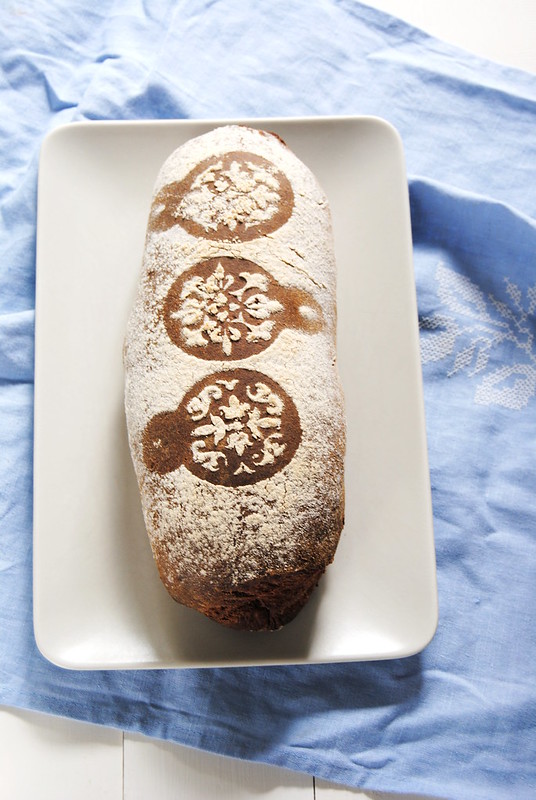 |
We kind of did both. Had a quiet day on Sunday, just the five of us at home. The egg hunt in the morning, lunch and a walk around the town in the afternoon, with ice cream although the weather was not really great. After the most beautiful wether during the week with warmest 25°C we had a sudden drop in temperature and 8-12°C over the weekend, with crazy freezing wind blowing, but wen out just the same.
Yesterday (Monday) we decided to visit Ravenna, a beautiful town near the Adriatic coast, just a bit longer than an hour drive from Modena, with a couple friends. Kids and all of us had fun being tourists for a day. The town is very, very beautiful, it's really worth visiting, with it's marvelous monuments, churches, cathedrals, museums, and in particular mosaics worth seeing. It may be less known than some bigger Italian towns like Venice, Florence etc, but it's absolutely worth visiting. And the sea is just a few chilometers away and we spent half an hour on the beach, too, running on the sand, flying a kite and just breathing the salty air.
 |
Sourdough Rye bread.
Now, I really like rye bread, and I often add a small amount of rye flour to other flours. And the flavour it brings is just wonderful. But I wanted to create that dark rye bread, that, however, wasn't stone hard like those I sometimed bought.
And after reading a few different recipes (one by J. Oliver and a couple by J. Hamelman) I set on preparing this bread, combining bits of all of them with the basic baking method and technique I've been using lately. That is to say, I took Jamie's recipe as a basis for ingredients, adapting it to sourdough starter, combined it with prefement tecnique I saw in most or all of the Hamelman's recipes, and applied it to another method from tartine bread that I've made often over the past few weeks.
The result was fantastic. I couldn't believe how good it was. Tastier than I ever expected, softer than I ever hoped it could be. Perfectly balanced flavours.
Combined with just some cheese spread, or cream cheese and smoked salmon, with stews, anything. I loved it with everything.
For me, this is at the moment, the best rye bread I've ever made.
 |
Sourdough Rye Bread
Preferment:
* 50 g liquid sourdough starter (with 100% hydration)
* 50 g water
* 25 g whole grain rye flour
* 25 g bread flour
Main dough:
* all the preferment
* 150 g whole grain rye flour
* 350 g wheat flour (all white or 75 g whole wheat + 275 g white flour)
* 150 g milk
* 150 g water
* 50 g dark molasses
* 20 g dark chocolate (with 90% cocoa)
+
* 25 g water
* 10 g salt
* 5 g raw cane sugar

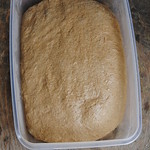
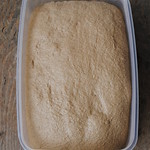
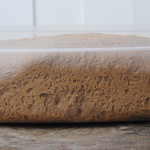
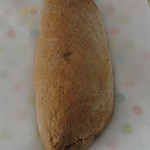
Feed your sourdough starter and let it ferment 3-4 hours before you start preparing the preferment.
I fed 20 g of my white sourdough starter with wholegrain rye flour (20g).
Once the sourdough starter is ready, prepare the prefermt. Simply combine the sourdoguh starter, the water and the flours in a bowl, seal and let ferment for 10-12 hours.
for the bread dough, combine the milk with molasses and chopped chocolate in a saucepan. Heat over low heat until the molasses and chocolate are melted. Remove from heat and let it cool down. Combine with water.
Mix and sift together the flours or put them in a mixing bowl and whisk to combine.
Add the preferment and the mixture of liquid ingredients, mix with a wooden spoon or by hand to combine, and get a roughly mixed dough.
Cover/seal with a piece of plastic wrap, and let rest for 1/2 hour.
Mix the salt and sugar with 25 g water, add the mixutre to the dough and mix well with your hands. The dough will start getting smoother and softer at this point.
Let it rest for 1/2 hour. Then drop the dough on the slightly floured kneading board, flatten it gently with your hands to form a square, fold in threes - upper and lower third towards the middle, overlapping, then the right and left third in the same way. In the end round the dough with your hands and place it with the seal down back into the bowl. Repeat the folding after 1/2 hour.
Place the dough into the bowl and let it double in size.
When the dough has doubled, you may decide to retard it by placing it in the fridge for up to 24 hours, or proceed to form and bake it on the same day. The dough matures in the fridge and the flavours and structure improve. In case you transfer the dough in the fridge, once you take it out let it sit for a couple hours at room temperature before you proceed.
When the dough is ready/risen, drop it on a slightly floured kneading board and flatten gently with your hands to form a rectangle.
Roll the dough up to form a loaf.
Place it on a well floured cotton or linen cloth and wrap it. Let the loaf proof for about 2 hours.
Preheat the oven to 250°C with the baking stone or an empty baking tray in it. The baking stone needs at least 30-45 minutes to heat well. At the same time place a small baking dish to the bottom of the oven (to throw water or ice in to create steam).
Check if the bread loaf is ready for baking by pressing the dough gently with your index finger. If no fosset is left, the dough needs to proof more. If there's a little fosset left, and it slowly rises up and disappears, the loaf is ready to go into the oven.
Transfer your loaf into the oven on the hot stone or baking tray. At the same time throw a glass of hot water or a handfull of ice cubes into the small baking dish on the bottom of oven to create steam (steam will help the crust stay soft during the initial 15 minutes of baking allowing a better oven spring of the loaf).
After the first 15 minutes, lower the heat to 200°C and remove the steaming dish. 15 minutes later, lower the heat again, to 180°C and finish baking your loaf (about 25 minutes).
If you like crusty bread, during the last 5 minutes leave the oven door slightly open.
Remove from the oven and let the bread cool down on a cooling rack before cutting it.
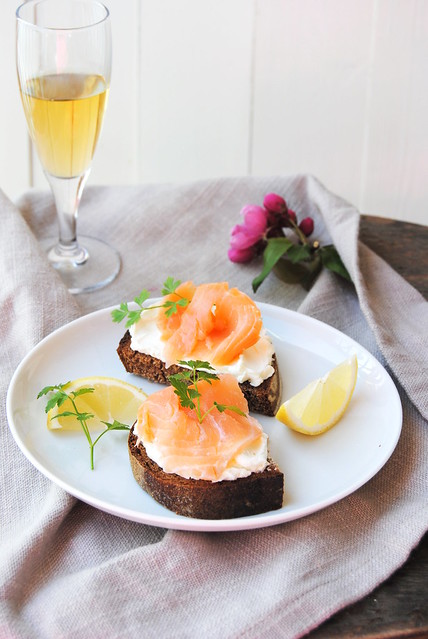 |
Pane al segale con lievito madre
Prefermento:
* 50 g di licoli/lievito madre liquido (con idratazione al 100%)
* 50 g di acqua
* 25 g di farina di segale integrale
* 25 g di farina tipo "0"
Impasto del pane:
* tutto il prefermento
* 150 g di farina di segale integrale
* 350 g di farina di grano tenero (tutta tipo "0" o 100 g tipo "1"+ 250 g tipo "0" o 75 g di farina integrale + 275 g di farina tipo "0")
* 150 g di latte
* 150 g di acqua
* 50 g di melassa scura
* 20 g di cioccolato fondente con 90% di cacao
+
* 25 g di acqua
* 10 g di sale
* 5 g di zucchero di canna integrale
Prima di iniziare rinfrescate il vostro licoli una volta con la farina di segale integrale (per non farlo con tutto il lievito ho rinfrescato solo 20 g + 20 g di farina di segale + 20 g di acqua) e lasciate fermentare fino al raddoppio, 3-4 ore.
Preparate il prefermento mescolando il licoli con l'acqua e le due farine in una ciotola. Coprite con la pellicola e lasciate fermentare tutta la notte (circa 10-12 ore).
Mescolate la melassa con il latte e il cioccolato spezzettate in un pentolino e scaldate sul fuoco fino a far sciogliere il cioccolato e la melassa. Aggiungete l'acqua e lasciate intiepidire.
Mette le farine nella ciotola dove impasterete il pane e mescolatele.
Aggiungete tutto il prefermento e gli ingredienti liquidi. Impastate grossolanamente per far idratare la farina, coprite e lasciate riposare 1/2 ora.
Mescolate 25 g di acqua con il sale e lo zucchero. Aggiungeteli all'impasto e impastate di nuovo per farli assorbire bene.
Coprite e lasciate riposare di nuovo 1/2 ora. Fate due giri di pieghe a tre a distanza di 1/2 ora una dall'altra (appiattite leggermente l'impasto con le mani formando un quadrato; piegate il terzo superiore e quello inferiore verso il centro, e poi lo stesso da destra e sinistra, formando alla fine una palla).
Dopo il secondo giro di pieghe lasciate raddoppiare l'impasto. Volendo, potete trasferire l'impasto in frigo a questo punto e farlo maturare fino a 24 ore prima di procedere. In questo caso fatelo acclimatare a temperatura ambiente un paio d'ore prima di procedere.
Una volta raddoppiato l'impasto, rovesciatelo sulla spianatoia leggermente infarinata. Appiattitelo con le mani e poi arrotolatelo formando un filoncino.
Sistemate il filoncino sul telo di cottone o lino infarinato, avvolgetelo e fatelo lievitare 1,5-2 ore.
Fate la prova del dito per verificare se il pane è pronto per la cottura - premete l'impasto con un dito, se non rimane l'impronta l'impasto deve lievitare ancora; se si crea la fossetta che pian piano torna su, il pane è pronto per la cottura.
Scaldate il forno a 250°C insieme alla pietra refrattaria o una placca da forno se non avete la pietra. Sul fondo del forno mettete una teglia più piccola o un pentolino (servirà per mettere l'acqua o ghiaccio per creare il vapore).
Quando il forno e la pietra sono ben caldi (ci vogliono minimo 30-45 minuti per scaldare bene la pietra), trasferitevi il pane e contemporaneamente versate un bicchiere di acqua calda o una manciata di cubetti di ghiaccio nel pentolino piccolo sul fondo (il vapore aiuta a non formare la crosta dura sulla superficie del pane e in questo modo l'impasto si sviluppa meglio in cottura).
Dopo 15 minuti abbassate la temperatura del forno a 200°C e togliete il pentolino con l'acqua.
Dopo altri 15 minuti abbassate ancora la temperatura, a 180°C e proseguite la cottura per altri 25 minuti circa.
Se desiderate ottenere una crosta più croccante, lasciate la porta del forno leggermente aperta negli ultimi 5 minuti.
Lasciate raffreddare il pane su una griglia prima di tagliarlo.
 |
Iščitala sam nekoliko recepata (između ostalog jedan Jamieja Olivera i još par Jefferyja Hamelmana), primijenila ponešto od svakog na recept za kruh koji inače najčešće radim u zadnje vrijeme. Rezultat je bio iznenađujuće dobar. Tamni raženi kruh, prepun okusa, posebne arome, a mekan poput spužve što je bio moj najveći strah, jer nisam htjela ispeći kamen kojim nekoga ozlijediti.
Neka vas ne zbune sastojci, kad vidite melasu, čokoladu i šećer pomislit ćete odmah da se radi o slatkom kruhu, ali nije tako. Melasa zapravo nije tako slatko, više je gorkastog okusa, a tamna čokolada s 90% kakaa također.
Po sastojcima je nasličniji kruhu J. Olivera, a Jamie ga preporučuje uz dimljenu ribu (ja sam isprobala s dimljenim lososom i divno se slaže), sireve, ali i uz razna druga jela (sarma se nije bunila, pa toliko od mene ;)))
Raženi kruh s prirodnim kvasom
Predtijesto/starter:
* 50 g tekućeg kvasa (sa 100%-tnom hidratacijom)
* 50 g vode
* 25 g integralnog raženog brašna
* 25 g bijelog pšeničnog brašna
Tijesto za kruh:
* sav starter
* 150 g integralnog raženog brašna
* 350 g pšeničnog brašna (samo bijelo ili 75 g integralnog + 275 g bijelog brašna)
* 150 g mlijeka
* 150 g vode
* 50 g tamne melase
* 20 g tamne čokolade s 90% kakaa
+
* 25 g vode
* 10 g soli
* 5 g integralnog smeđeg šećera
Ako imate kvas od bijelog brašna, prije početka pripreme, nahranite ga integralnim raženim brašnom (ja sam uzela 20 g kvasa i dodala mu 20 g raženog brašna i 20 g vode). Ostavite kvas da se udvostruči, 3-4 sata, a zatim pripremite predtijesto/starter.
Pomiješajte kvas, vodu i obje vrste brašna. Izmiješajte vilicom, pokrijte prozirnom folijom i ostavite da stoji preko noći (10-12 sati).
Za glavno tijesto, zagrijte mlijeko s melasom i nasjeckanom čokoladom dok se sve ne otopi. Ostavite da se umlači.
Dodajte u ovu smjesu vodu.
Stavite oba brašna u zdjelu i pomiješajte ih pjenjačom. Dodajte tekuće sastojke i predtijesto i zamijesite grubo tijesto. Pokrijte i ostavite da stoji 1/2 sata.
Pomiješajte sol i šećer s 25 g vode pa dodajte tijestu i ponovno zamijesite.
Pokrijte i ostavite da stoji 1/2 sata. Istresite tijesto na radnu površinu, lagano pobrašnjenu, rastanjite ga rukama na kvadrat pa preklopite na troje (gornju i donju trećinu prema sredinu, zatim s desne i lijeve strane prema sredini). Zaokružite rukama u kuglu pa stavite u zdjelu. Nakon pola sata ponovite preklapanje.
Stavite tijesto da se diže dok se ne udvostruči. Nakon toga možete ili odmah oblikovati kruh ili tijesto staviti u hladnjak i odgoditi pečenje na 24 sata. Ako se odlučite staviti tijesto u hladnjak, kad ga izvadite, pričekajte sat do dva prije nego ćete ga oblikovati.
Oblikovanje: istresite tijesto na lagano pobrašnjenu površinu, rastanjite ga rukama pa zarolajte i oblikujte štrucu.
Stavite štrucu na pobrašnjenu krpu i zamotajte je. Ostavite je da se diže oko 2 sata.
U međuvremenu zagrijte pećnicu na 250°C. Ako imate kamen za pečenje zagrijte ga zajedno s pećnicom (kamen treba zagrijavati najmanje 30-45 minuta), ako nemate kamen možete staviti prazan pleh na kojem ćete peći kruh. Istovremeno na dno pećnice stavite manji pleh ili šerpicu u koju ćete kasnije sipati vodu ili led za paru.
Kad je kruh spreman za pečenje (provjerite je li se kruh dovoljno digao tako što ćete kažiprstom pritisnuti tijesto: ako ne ostane otisak prsta, kruh se treba još dizati, ako ostane otisak i polako se vrati gore kruh je spreman za pečenje).
Prebacite kruh u pećnicu, na kamen ili vruh pleh. Istovremeno ubacite u plah na dnu pećnice šaku kockica leda ili jednostavno čašu vruće vode (para će pomoći da kora kruha ne postane odmah tvrda i tijesto će se bolje razviti u pečenju).
Nakon 15 minuta možete izvaditi pleh s vodom, smanjite temperaturu na 200°C i nakon još 15 minuta na 180°C i ispecite kruh do kraja (oko 25 minuta). Zadnjih pet minuta možete ostaviti odškrinuta vrata pećnice ako volite hrskaviju koricu.
Ostavite kruh da se ohladi na rešetki.
 |
complimenti bellissimo pane con una decorazione fantastica
ReplyDeletenevjerojatan! nemam riječi koliko mi sesvidio! bravo, bravo, ....
ReplyDeleteComplimenti, strepitoso questo pana alla segale, perfetto con la pasta madre!!!!
ReplyDelete